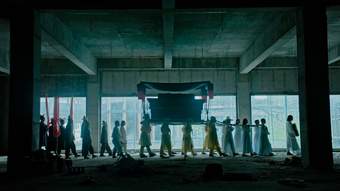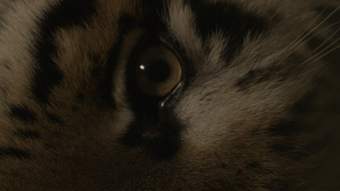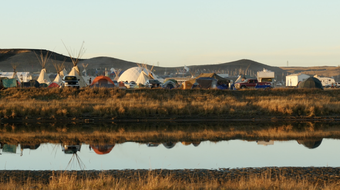Jane Jin Kaisen negotiates and mediates the political history, cosmology, and spiritual culture of Jeju Island through feminist re-framings of myths, and by addressing the haenyeo sea diving culture, Jeju shamanic practice connected to the ocean and the natural environment, and the Jeju April Third Massacre. In 1948, shortly before the outbreak of the Korean War, state authorities and rightist paramilitary groups waged a 'red hunt' in South Korea’s Jeju Island, unleashing genocidal violence upon large parts of the civilian island population.
In Burial of this Order, a procession of non-conforming people – from musicians, artists and poets to anti-militant activists, environmentalists and diasporic, queer and trans people – carry a coffin together through the ruins of what turns out to be an abandoned resort on the South Korean island of Jeju. It soon becomes clear that this is no traditional Confucian funeral. Age and gender roles are subverted, the coffin is draped in dark camouflage colours and the traditional portrait of the deceased is replaced by a black mirror. In the field between funeral ritual, political protest and carnival performance, the procession marches through the ruins of capitalist modernity. Time and place begin to lose their stability as mythical Dokkaebi deities pass through the building, a heavy rain and wind blow through its cavities, and the group, in a revolutionary moment, overthrows and dismantles the prevailing order. Jane Jin Kaisen’s interdisciplinary work not only activates Jeju’s violent history as a site of oppression and rebellion, but is a work with universal power.
For Offering – Coil Embrace Jin Kaisen collaborated with a group of female divers in Jeju who have been involved in the environmental preservation of the island. With them, she crafted an underwater choreography that draws upon Jeju shamanic myths connected to the ocean and the symbolic meanings of sochang. Sochang is a long white piece of cotton cloth associated with weaving, caring for kin. A symbol of the human cycle of life and death, sochang is integral to rites of passage in Korea. Filmed in slow motion with a Black Magic pocket cinema camera, and gradually tinged with red, the film approaches the ocean as a medium and as a vessel of ancestral knowledge and matrilineal connection, but also as a space of exile and death.
Kaisen's most recent video work brings together a group of eight women in their 70s and 80s. It is filmed by the lava rock coast of Jeju Island near an islet that used to serve as a shamanic shrine for the wind goddess. The women, who have worked and made a living together for most their lives as haenyeo sea divers, used to depart together for the sea from this very location. The hometown of Kaisen’s grandparents, this is also where her grandmother used to work as a haenyeo sea diver.
Carefully focusing on their hands, gestures and facial expressions, the camera registers the lives and lived experience of the aging women and their sense of community and connectivity to the rocks, the sea and the wind surrounding them. As in Burial of this Order and Offering – Coil Embrace, sochang is a central symbol in this new work where the women are seen meticulously folding and caring for the fabric. As the piece unfolds, they start connecting the long rolls of sochang until it comes to form a large spiral enveloping the black lava rocks.
This screening is part of a three-day programme devoted to artists engaging with a transnational movement of resistance. Further information is available on our Tate Film page.






